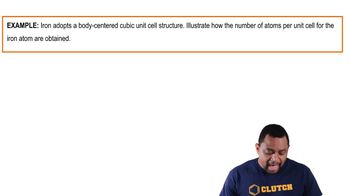Here are the essential concepts you must grasp in order to answer the question correctly.
Density and its Calculation
Density is defined as mass per unit volume, typically expressed in grams per cubic centimeter (g/cm³). To calculate the density of a substance, one can use the formula: density = mass/volume. In this context, knowing the density of the metal allows us to relate it to the atomic mass and the volume of the unit cell.
Recommended video:
Body-Centered Cubic (BCC) Lattice
A body-centered cubic lattice is a type of crystal structure where atoms are located at each corner of a cube and one atom is positioned at the center of the cube. This arrangement affects the packing efficiency and the volume occupied by the atoms, which is crucial for calculating the atomic mass based on the unit cell dimensions.
Recommended video:
Body Centered Cubic Example
Unit Cell Volume and Atomic Mass Relationship
The volume of a unit cell can be calculated using the edge length of the cube, raised to the third power (V = a³). In a BCC structure, there are two atoms per unit cell, and the relationship between the mass of the atoms, the density, and the volume of the unit cell can be used to derive the atomic mass of the metal using the formula: atomic mass = (density × unit cell volume) / number of atoms per unit cell.
Recommended video:




